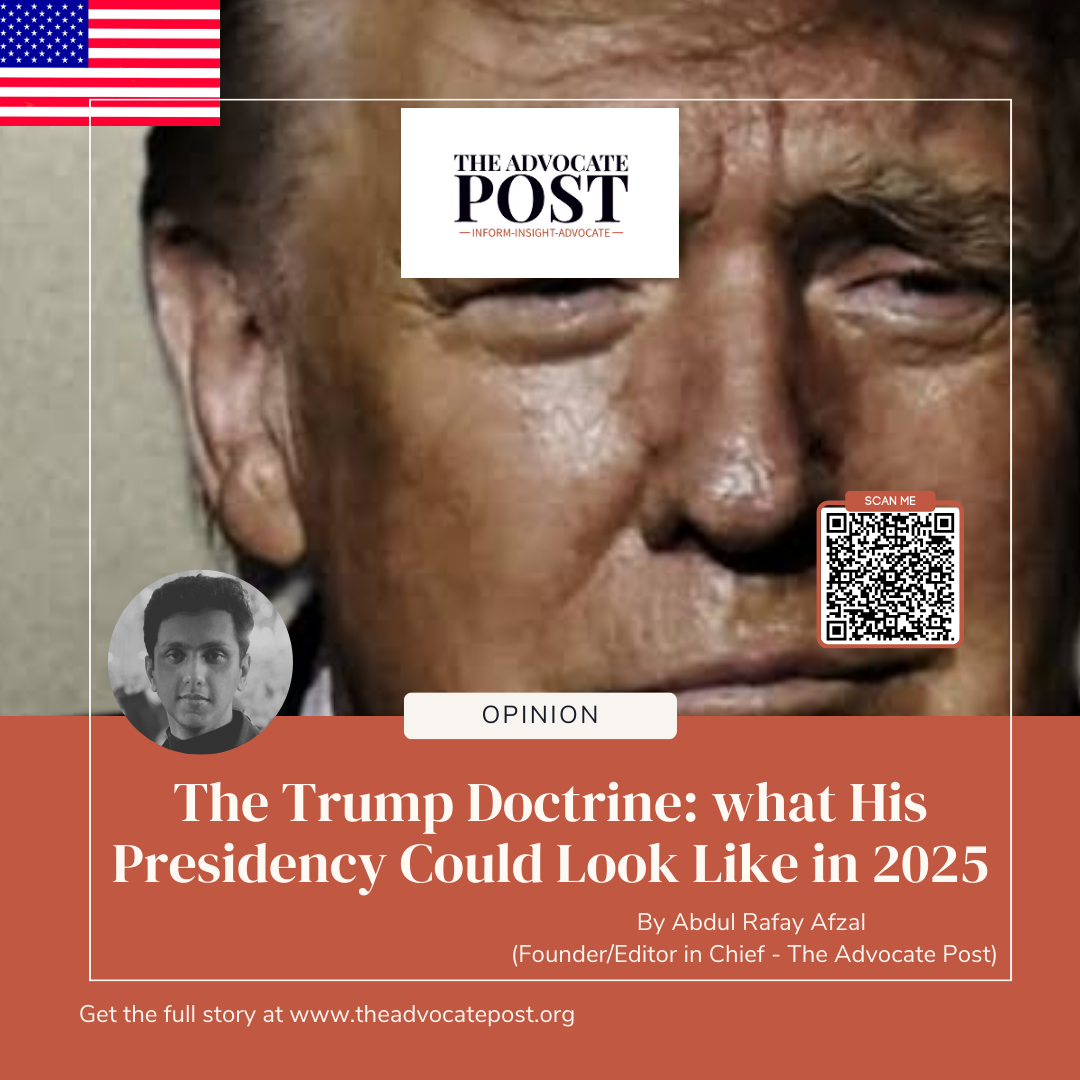By Abdul Rafay Afzal (Founder/Editor in Chief – The Advocate Post)
With Donald Trump securing the 2024 U.S. presidential election as his second term and 47th President of the centre focus of the World United States, promises to redefine both domestic policies and the U.S.’s global stance. Building on his initial “America First” doctrine, Trump’s 2025 agenda is expected to be even more aggressive and transformative, affecting legal frameworks, domestic tranquility, and international relations.
A cornerstone of Trump’s renewed mandate will be his desire to further influence the judiciary with conservative judges who align with his policies. By reshaping the judiciary, Trump’s administration aims to cement right-wing ideologies on sensitive issues like abortion, gun rights, and regulatory authority. Coupled with his legislative agenda, this effort will contribute to a shift in the legal landscape, potentially curbing Congress’s oversight over the executive branch, thus steering more power towards the presidency.
Domestically, Trump’s “law and order” policies could become more stringent. From stricter border security to crackdowns on civil unrest, Trump’s administration will likely intensify its efforts to maintain control. This might involve significant increases in funding for law enforcement and an expanded federal response to what Trump describes as rising “anarchist” threats. Policies targeting the perceived “deep state” within federal agencies may result in widespread reorganizations and dismissals, especially within bodies like the FBI, CIA, and the Department of Justice.
On the global front, the Trump Doctrine 2.0 is poised to be even more transactional and protectionist. The “America First” policy will focus on bilateral agreements, signaling a continued retreat from multilateral diplomacy and globalism. In trade negotiations, Trump is expected to prioritize American jobs, reduce foreign competition, and decouple from China. This policy direction will likely strain relations with allies who favor collective global engagement over transactional policies.
Trump’s commitment to ending “endless wars” sees a continuation of troop withdrawals from regions like Afghanistan, Iraq, and Syria. His strategy will bank on negotiating peace deals and placing more security responsibilities on regional powers. This disengagement could lead to a reduced U.S. military presence in Europe and the Middle East, possibly affecting global stability and weakening longstanding alliances.
Focusing on the Horn of Africa, Trump’s administration could see a strategic shift with a greater emphasis on Somaliland. By recognizing Somaliland’s independence from Somalia, the U.S. would aim to counter Chinese influence in East Africa and promote stability. This move draws parallels with the U.S.’s past support for Kosovo’s independence to foster stability in the Balkans, highlighting an approach where U.S. recognition aims to bolster regional security and deter terrorism In relations with China and Russia, Trump is expected to maintain economic pressures on China, enforcing aggressive trade policies to curb Chinese influence in global tech and manufacturing sectors. While relations with Russia might see a pragmatic reset, it will be a delicate balance of competition in areas like cyber warfare and nuclear arms control, against more direct diplomacy.
However, Trump’s administration may adopt a firmer stance on Russian activities in Ukraine, while possibly sidelining multilateral institutions like NATO. The economic policy under Trump’s second term will likely be marked by an extension of protectionist trade measures, characterized by increased tariffs on imports, favoring American manufacturing, and promoting “Buy American” policies. These strategies aim to reshore jobs and promote domestic production, but could face significant international backlash and contribute to trade tensions.
Trump’s focus on cybersecurity and national defense will emphasize modernizing the military and intelligence capabilities with advances in AI, space defense, and cyber defense infrastructures. Coupled with a strategy of reduced troop deployments, this indicates a shift towards high-tech warfare capabilities, preparing America for the digital age of conflict.
The relationship with global allies will also be redefined. Trump could continue pressuring NATO allies on defense spending and challenge European nations on trade and immigration. This could lead to a push for more bilateral agreements while reducing commitment to traditional multilateral frameworks. Republicans second term under Trump administration might further distance the U.S. from international institutions like the United Nations, the World Health Organization, and the Paris Climate Agreement, focusing on policies that, in his view, would protect American sovereignty without the constraints of global consensus but as World is not the same as before so surprises can be seen in the future.
In conclusion, Trump’s second term will likely reflect a more refined and aggressive “America First” doctrine. Both domestically and internationally, his administration will focus on reducing U.S. military presence abroad, reshaping trade policies, and reinforcing national security. While his approach to global issues like Somaliland, China, and the Middle East evolves, the overarching theme will be one of strategic diplomacy and disengagement from entangling conflicts. As Trump’s victory in 2024 solidifies, it signals a continuation of his populist agenda, shaping the next four years with a focus on American exceptionalism and redefined global engagements.
Author is from Lahore, Pakistan. Editor in Chief of The Advocate Post and Pakistan’s youngest international journalist. He writes perceptive columns on geopolitics, international relations, and legal affairs etc. in more than 13 countries providing unique insights into the global landscape in different Pakistani and International Newspapers and Media outlets in English & Urdu languages. He can be reached at @arafzal555 on instagram or email rafayafzal555@gmail.com






